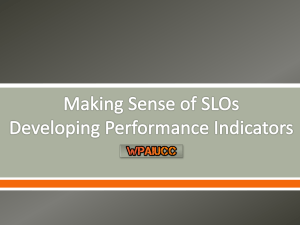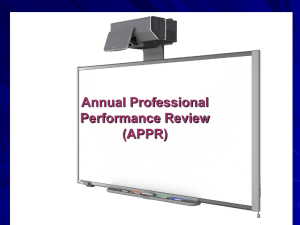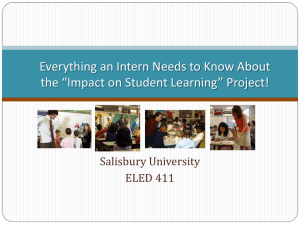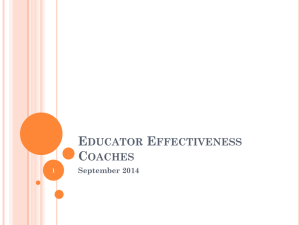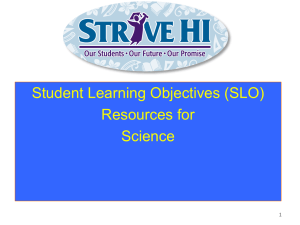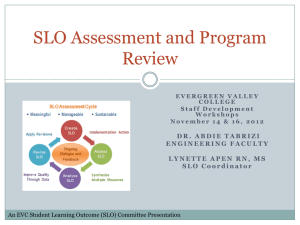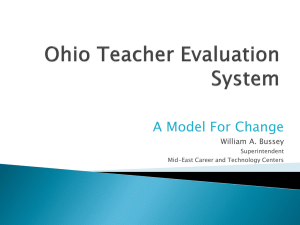SLO Writers Workshop - HudsonSLO
advertisement
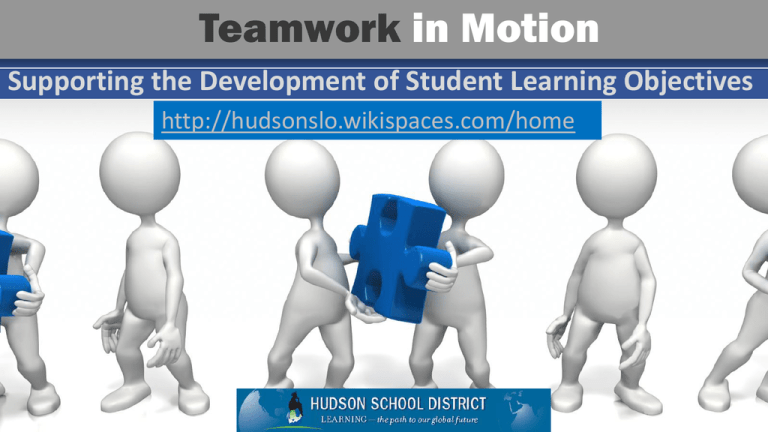
Teamwork in Motion Supporting the Development of Student Learning Objectives http://hudsonslo.wikispaces.com/home Learning Targets Describe the value of Student Learning Objectives. (School Learning Objective) Understand the SLO process from multiple perspectives. Plan a support system for developing quality SLOs to transform student and adult learning. Todays Meet http://todaysmeet.com/WASCDSLO Agenda 4-5:15- SLO Conversation 5:15-5:30- Break 5:30-6- Panel Discussion to Answer Questions 6-6:30- Roundtable Discussions 1. 2. 3. 4. 5. Teacher Perspective- Deb & Amanda Specialist Perspective- Amy & Jodi Administration’s Support- Susie Launching SLO in the High School - Peg Wiki exploration- Independently Connect the Dots Student Learning Objectives Multiple Measures SMART Goals Improved Student Learning Common Assessments Common Core State Standards Focus For Collaboration Things Effective Teachers Do Table Talk http://youtu.be/g1Cw34t5pv8 Things Effective Teachers Do Table Talk • Assess students to determine their instructional levels and clarify their academic needs. • Set instructional goals for students. • Design strategies and identify resources to address identified needs. • Monitor and assess student progress throughout the school year and adjust instruction accordingly. • Work cooperatively with colleagues to share professional expertise. How is this like a SLO? The SLO Process systemizes what effective teachers do. SLO Speak Purposes of SLO’s 1. Focus on student results 2. Connect goal setting processes to the SLO Process 3. Explicitly connect teaching and learning 4. Improve instructional practices and teacher performance 5. Serve as a tool for school improvement Who can support the SLO Process? Principal Learning Services Leadership Team/ SMART Goal Team Colleagues during collaboration time Instructional Coaches Peer Coach Superintendent Types of SLO Attainable or Growth Goals Tiered Whole Group Sub Group Individual Program (Educational Specialists) Number of Students Tiered SLO- Baseline Data U.S. History Assessment Achievement Levels • Primary sources comparative analysis • District-developed rubric for high school students Tiered SLO During the course of this school year, all students will make measurable progress in U.S. History as measured by the district-developed primary sources comparative analysis rubric for high school. Students will improve their scores as follows: Students scoring at the Novice and Developing levels on the preassessment will improve to the Proficient level on the postassessment. Students scoring at the Proficient level on the pre-assessment will improve to the Exceeding level on the post-assessment. Students scoring on the Exceeding level on the pre-assessment will have their pre-assessments re-scored using the College and Professional level rubric, and will improve their scores by one level on the post-assessment. Tiered Example of Goals Student Student 1 Student 2 Student 3 Student 4 Student 5 Student 6 Student 7 Student 8 Student 9 Student 10 Student 11 Student 12 Student 13 Student 14 Student 15 Student 16 Student 17 Student 18 Student 19 Student 20 Baseline score Needed Final Score Novice Novice Novice Novice Novice Novice Developing Developing Developing Developing Proficient Proficient Proficient Proficient Proficient Proficient Proficient Proficient Proficient Proficient Proficient Proficient Proficient Proficient Proficient Exceeding Exceeding Exceeding Exceeding Exceeding Exceeding/College: Novice Exceeding/College: Developing Exceeding/College: Developing Exceeding/College: Developing Exceeding/College: Proficient College: Developing College: Proficient College: Proficient College: Proficient College: Exceeding Support and Strategies 1. Understand the expectations for disciplinary literacy in the CCSS and create instruction matched to these goals. 2. Classroom supports with notes and flipped lessons online. 3. Create student friendly rubric to use with students. Whole Group SLOs Data suggest that students come with relatively similar readiness levels for the content being taught. For outliers (exceptionally low or exceptionally high performing students), individual SLOs may need to be developed. May be more likely in a course in which prerequisite scores or courses are necessary Whole Group SLO Baseline Data Strengths: Conventions Descriptive language Area of need: 28% met grade level proficiency on developing a character. 23% met grade level expectations on developing a conclusion. Whole Group- 5th Grade Writing By June 2013, 80% of all 5th graders in my class will independently demonstrate their grade level proficiency on the district rubric for narrative writing of: 1. Orienting the reader by establishing a situation and introducing a narrator and or characters. 2. Providing a conclusion that follows from a narrated experience or events. Strategies and Support 1. Understand the expectations for narrative writing in the CCSS and create instruction matched to these goals. 2. Determine exemplar papers in the 2 criteria and use for instruction. 3. Create authentic opportunities for students to write throughout the day. 4. Use mentor texts to model good writing craft. 5. Create a student friendly rubric for students to self reflect and set goals. End of the Year Data Sub Group SLO- Reading F & P Baseline data shows 6/23 (red) 2nd grade students began the year below the monthly target for the Fountas and Pinnell Reading Assessment. These 6 students are my sub group. Subgroup Reading Goals By June 2013, the six students below grade level will increase 5 levels by the end of the year. Strategies and Support • Guided Reading 3-4 times a week for these students • Goal setting with students • Comprehension strategies taught the same with school and home • Target interventions based on need to be utilized during our intervention block • Progress monitor growth • Fluency program- Read Naturally Individualized SLOs Used for smaller groups of students with a variety of readiness levels and background knowledge. Acceptable amounts of progress are often dependent on students’ historical academic performances. When working with special populations, individual SLO’s may be appropriate. Individual SLO During 2012-13, each student will make a growth of 65 points based on the common assessment Student Student 1 Student 2 Student 3 Student 4 Student 5 Student 6 Student 7 Student 8 Student 9 Student 10 Student 11 Student 12 Student 13 Student 14 Student 15 Student 16 Baseline score Growth Objective 0 0 0 0 2 4 4 6 10 10 12 12 14 14 18 20 65 65 65 65 65 65 65 65 65 65 65 65 65 65 65 65 Needed Final Score 65 65 65 65 67 69 69 71 75 75 77 77 79 79 83 85 Strategies and Support 1. Goal setting. 2. Small group instruction. 3. Personalized work. Program SLO- PBIS Baseline Data 2010-11– 119 bottom lines= .67/day 2011-12- 101 bottom lines= .56/ day 2012-13— 115 bottom lines= .64/ day Program SLO During the 2013-14 school year, our students’ bottom line behaviors K-5 at Hudson Prairie School will reduce from .64 to an average of .5 referrals per day which will keep students in classrooms and improve student learning. Strategies and Support • Begin tracking minor behaviors • Begin Check In Check Out system • Have a PBIS refresher in Feb. since our referrals were highest in March • Increase supervision on the playground to 1 adult for 50 students since the playground is the area where most bottom lines occur • Coaching of noon duty staff Deb’s SLO Process What is specific area that my students need improvement? Reflect What is an attainable yet rigorous goal based on the baseline assessment? Should it be differentiated based on results? Does it address all components in the rubric? Act Baseline assessment Write SLO Choose What is my SLO focus? What is an appropriate assessment to measure the goal? Share Criteria and Guiding Questions Staff Meetings and structured collaboration with Principal, Peer Coaches, Instructional Coaches Data Review and Gaining Focus Reading Writing Math Content Learning Focus Develop an assessment to match need Assessment Checklist 1. Does it follow the keys to quality assessment? • Purpose • Targets • Design • Communication • Student Involvement 2. Can it be used throughout the year to measure growth? 3. Does it align with the SLO? 4. Is it reliable and valid? Give Baseline On Demand Writing Baseline Data Analysis 3/22= 13% meeting grade level proficiency on writing rubric. Focus and Type of SLO What’s my focus? Narrative Writing What type of SLO is appropriate? • • • • • Tiered Whole Group Sub Group Individual Program What is a rigorous yet attainable growth goal? 80% School goal RtI tier 1 suggests 80-85% SMART Template- Whole Group By June of 2013 , 80% of the students in Mrs. Brastad’s 2nd grade class will independently demonstrate their grade level proficiency on the district’s rubric for narrative writing. Specific Measurable Attainable Results Oriented Time bound SMART Template- Tiered SLO By June of 2013, 100% of the students in Mrs. Brastad’s 2nd grade class will increase the number of criteria as proficient according to the district’s rubric for narrative writing. O increasing to 2 of 4 criteria 1 increasing to 3 of 4 criteria 2 increasing to 3 of 4 criteria 3 increasing to 4 of 4 criteria 4 increasing to exceeding category in 1 or more criteria Specific Measurable Attainable Results Oriented Time bound Strategies and Support 1. 2. 3. 4. Utilize mentor texts Utilize the gradual release process Small group writing Collaborative scoring of student writing and choosing exemplars to share with students 5. Lab classroom observations 6. Support from instructional coach Fill in SLO Form Reflect on the SLO with the criteria Practice at your table Reflect Act Approval Does it address all components in the rubric? Does it follow the SMART Goal criteria of being specific, measurable, attainable, rigorous, and time bound? Does the assessment match the goal? Is it rigorous? Choose How can I improve my actions? Step 2- Submit SLO for Approval SLO given to principal prior to the meeting for pre-planning support. At the meeting, we address questions and highlight criteria collaboratively and identify additional supports. Ongoing Support of SLO Lab classroom Feedback from instructional coach and principal Collaborative scoring for consistency Build in time for conversations about teaching and learning at collaboration meetings Professional learning specific to initiatives Individual data talks Reflect Act Continue actions and data collection Approval What is the progress students are making toward the goal? Individual and group Does the goal need revisions to make it attainable yet rigorous? How are the actions making an impact on student learning? What additional support or actions do you need? Choose Updated goal How canactions I improve my actions? Updated Step 3- Mid Year Review Opportunity to adjust goal based on data. Mid Year Conference http://www.youtube.com/watch?v=BpjY1po3yTg Reflect Act New SLO Did you What is the metprogress your goal? students are making Are there toward any circumstances the goal? Individual to consider? and group actions had the greatest impact? What Does the What are goal yourneed next revisions steps? to make it attainable How do you yet score rigorous? on DPI rubric? Choose Area to focus on for improvement and a possible SLO for the following year. Step 4 Goal Approval Goal Approval Conference http://www.youtube.com/watch?v=76uAJcKZPIg Still grappling with…. How can we allocate more TIME for this process? How do we provide differentiated support for our teachers and administrators? How do we support specialized teachers in writing SLO’s? How can we collect and use data effectively? How can we provide teachers with models of a high quality SLO? Kid President http://www.youtube.com/watch?v=lgQLqv9f4o&safe=active Reflect on Learning Targets Describe the value of Student Learning Objectives. Understand the SLO process from multiple perspectives. Plan a support system for developing quality SLOs to transform student and adult learning Panel Discussion- Questions? Hudson Prairie Team Susie Prather, Principal prathesm@hudson.k12.wi.us Deb Brastad, 2nd Grade brastada@hudson.k12.wi.us Amanda McCarthy, 5th Grade mccartar@hudson.k12.wi.us Jodi Magee, Media Specialist mageejs@hudson.k12.wi.us Amy Gallick, Music Specialist gallicae@hudson.k12.wi.us Differentiated Roundtables 1. 2. 3. 4. Teacher Perspective- Deb & Amanda Specialist Perspective- Amy & Jodi Administration’s Support- Susie Launching SLO in the High School Peg 5. Wiki exploration- Independently
